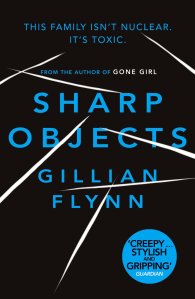Fiction – Kindle edition; Phoenix; 340 pages; 2009.
I recently took a couple of days off work in order to do some study for a certificate I’m enrolled in. The plan was to read lots of journal articles, to get my head in the required space, so that I could write a 3,000-word essay, which is due to be submitted at the beginning of August. Alas, I made the mistake of picking up Gillian Flynn’s debut novel Sharp Objects — and then I got so gripped by it that I spent all my study time reading it instead of doing what I was supposed to be doing.
Do I regret it? No. This is one of the creepiest, weirdest and most unusual books I’ve read in a long while. It’s also the most absorbing.
Unlike Flynn’s better known Gone Girl, which is about a couple whose marriage goes off the rails in a very dark, disturbing and ludicrous way, this one is more restrained — in prose style and plot — but feels all the stronger and more believable for it.
Two murders in a small town
The story revolves around the murder of two young girls, a year apart, in a small town in Missouri. Both girls were strangled, their bodies dumped in public places, their nails painted with polish and their teeth removed.
Reporter Camille Preaker, who grew up in Wind Gap but escaped it 10 or so years ago, is dispatched to her home town to report on the crimes for Chicago’s Daily Post. Of course, no one wants to talk to her — they don’t want the town’s tragedy turned into entertainment fodder for a national audience — and it’s an uphill struggle to even win the trust of the police.
Camille, who narrates the story in the first person using strong, forthright language, is headstrong, feisty and full of attitude, but she’s also got a few secrets of her own to keep: she’s a reformed self-harmer and for much of this novel she’s constantly battling her deep psychological need to carve words into her skin.
It doesn’t help that living back at home with her seriously kooky mother, oddly quiet step-dad and highly sexualised 13-year-old half sister brings back memories of the past: her younger sister, Marian, who died of an unspecified illness when Camille was a young teen still haunts her.
Southern Gothic
As you can probably tell this is not your average “who dunnit” — mainly because it’s more reliant on characterisation than plot, but also because Camille is constantly on the back foot trying to seek out clues from people who don’t want to help. In other words, there’s not much of a procedural element to it, but it is a good insight into how reporters do their legwork (although I don’t think it’s usual to sleep with the murder detective and then the prime suspect — just saying).
In fact, I’d suggest that Sharp Objects is probably closer to horror — don’t let that put you off — because it has all the feel and claustrophobic atmosphere of Southern Gothic (even though it’s set in the mid-west), something Donna Tartt might have cooked up with Stephen King. Consequently, it’s quite a dark, edgy read — there are scenes involving drug-taking and plenty of sex, for instance, but it’s all in keeping with the book’s themes and subject matter.
And while this is not the kind of “crime thriller” that is full of twists and turns, when the culprit is finally unveiled at the very end of the novel it feels like a genuine shock.
In 2007, Sharp Objects won the CWA New Blood Fiction award and the CWA Ian Fleming Steel award. It was shortlisted for the Gold Dagger (won by Peter Temple’s The Broken Shore) the same year.

